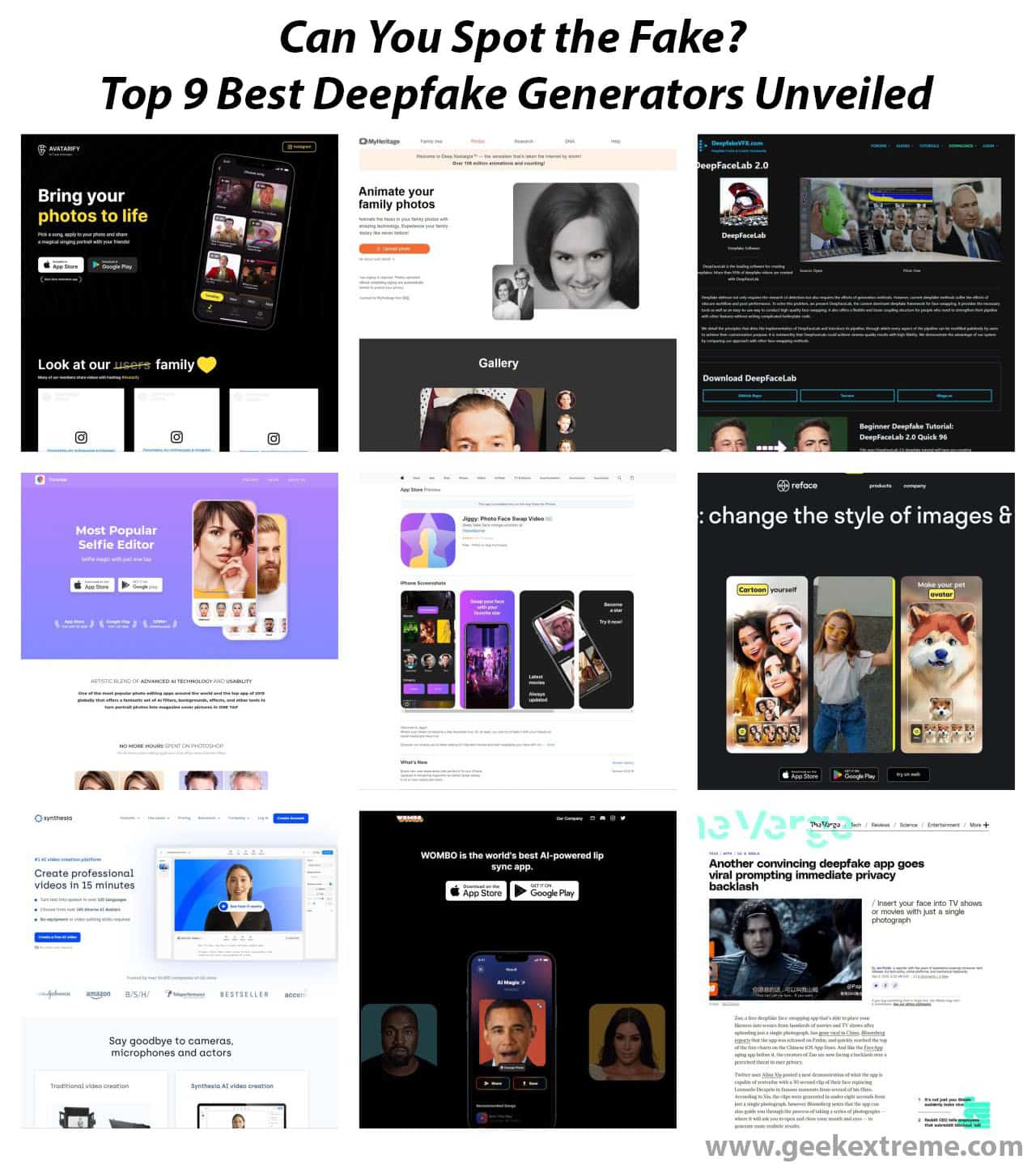Welcome to the fascinating world of deepfake generators! This cutting-edge technology allows users to create incredibly realistic images and videos, altering faces and even animating still photos for a wide range of purposes.
In this blog post, we will dive into the top 9 best deepfake generators available today, comparing their features, pros, and cons while also addressing the ethical concerns surrounding their use.
Key Takeaways
Deepfake technology utilizes AI and machine learning algorithms to create fake videos or images that mimic real people’s appearances and actions.
Popular deepfake generators like Reface, Zao, and MyHeritage Deep Nostalgia offer advanced features, user-friendly interfaces, and high-quality results but also raise ethical concerns surrounding privacy invasion, misinformation spread, and potential misuse in politics or the entertainment industry.
Responsible usage practices and explicit permission from individuals whose images are used can help mitigate the risks associated with these powerful tools. It is essential to stay informed on the latest developments of this rapidly-evolving technology while also keeping in mind our moral obligations as users.
Table of Contents
What Is Deepfake Technology?
Deepfake technology utilizes artificial intelligence and machine learning algorithms to create fake videos or images that mimic real people’s appearances and actions.
How Deepfake Technology Works
Deepfake technology is powered by artificial intelligence (AI) and machine learning algorithms to create hyperrealistic images or videos by replacing one person’s face with another.
The process begins with feeding the algorithm vast amounts of data in the form of images and videos. The AI then learns to map facial features from one individual onto another without losing important details such as lighting, shadows, and expressions.
For instance, if you’ve ever wanted to see yourself as a superhero saving the day like Iron Man or performing incredible dance moves from your favorite music video – deepfake technology allows you to do just that! However, it’s critical to remember that while these applications may be entertaining for some users when utilized ethically and responsibly, they also possess potential misuses, including manipulation in politics through fake news creation or privacy invasion cases involving non-consenting individuals’ faces being swapped inaccurately.
One notable example of deepfake technology involves the creation of a Princess Leia deepfake video that uses Millie Bobbie Brown’s face. This generated considerable controversy and raised concerns about the ethical implications of using someone’s likeness without their consent.
Potential Risks And Ethical Concerns
As the use of deepfake technology continues to rise, so do potential risks and ethical concerns surrounding it. A major worry is the spread of misinformation, wherein deepfakes can be used to create false narratives that could damage reputations or even manipulate public opinion.
Privacy invasion is another critical concern with deepfake apps and software. Without explicit permission from an individual whose images or videos are being manipulated, creating deepfakes may constitute unauthorized use of their likeness for potentially harmful purposes.
Manipulating someone’s image in a way they never consented to raises legitimate questions about consent and respect for personal boundaries.
Lastly, legal implications arise when addressing these serious ethical issues. While it’s not illegal to create deepfake content as long as it’s labeled as fiction and doesn’t mislead people intentionally, certain countries have introduced regulations and verification procedures aimed at combating the dangers posed by this rapidly-evolving technology.
Reface
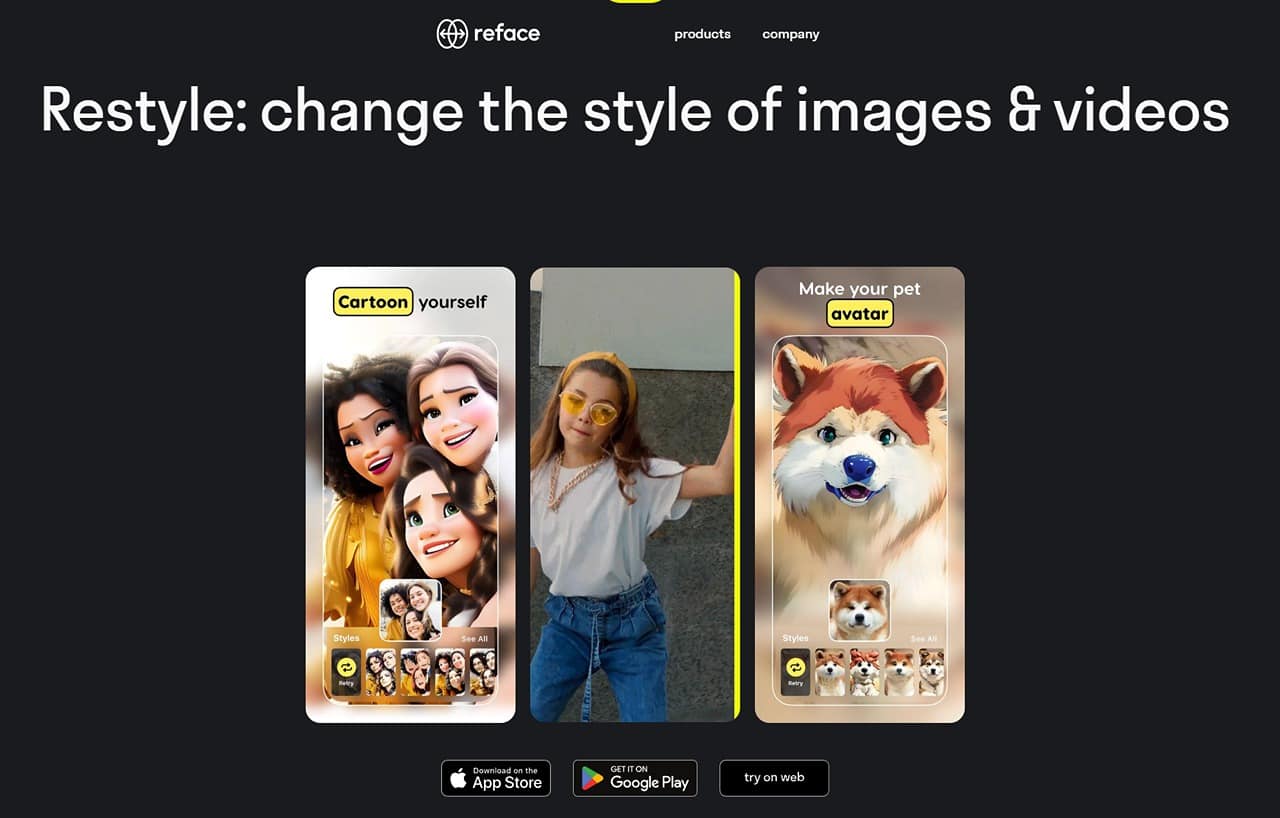
Reface is a popular deepfake app with an impressive refacing feature that allows users to seamlessly swap faces in videos and GIFs.
Features & Description
Reface, formerly known as Doublicat, stands out among the top deepfake generators with its user-friendly interface and impressive face-swapping capabilities.
Powered by advanced generative adversarial networks (GANs), this mobile app allows users to seamlessly merge their faces with those of popular figures and fictional characters in just a matter of seconds.
Available on both Android and iOS devices, Reface offers a free version as well as a Pro subscription plan at $3.99/month for additional features such as an ad-free experience and watermark-free outputs.
Notably, it is designed to be data-safe, which means your personal information stays private while using the app.
Pros & Cons
Reface is a popular deepfake generator known for its advanced AI technology and user-friendly interface. However, like any technology, it has its pros and cons. The table below highlights the advantages and disadvantages of using the Reface app.
| Pros | Cons |
|---|---|
| Easy to use and navigate. | Requires a subscription for some features and ad-free experience. |
| Large library of GIFs and videos to choose from. | Can be misused for impersonation or spreading false information. |
| Advanced AI technology provides realistic results. | Quality of deepfakes may vary depending on the input image. |
| Works on both iOS and Android devices. | Privacy concerns as users must grant the app access to their photos and camera. |
| Regular updates and improvements. | Potential ethical issues related to the use of deepfake technology. |
Zao
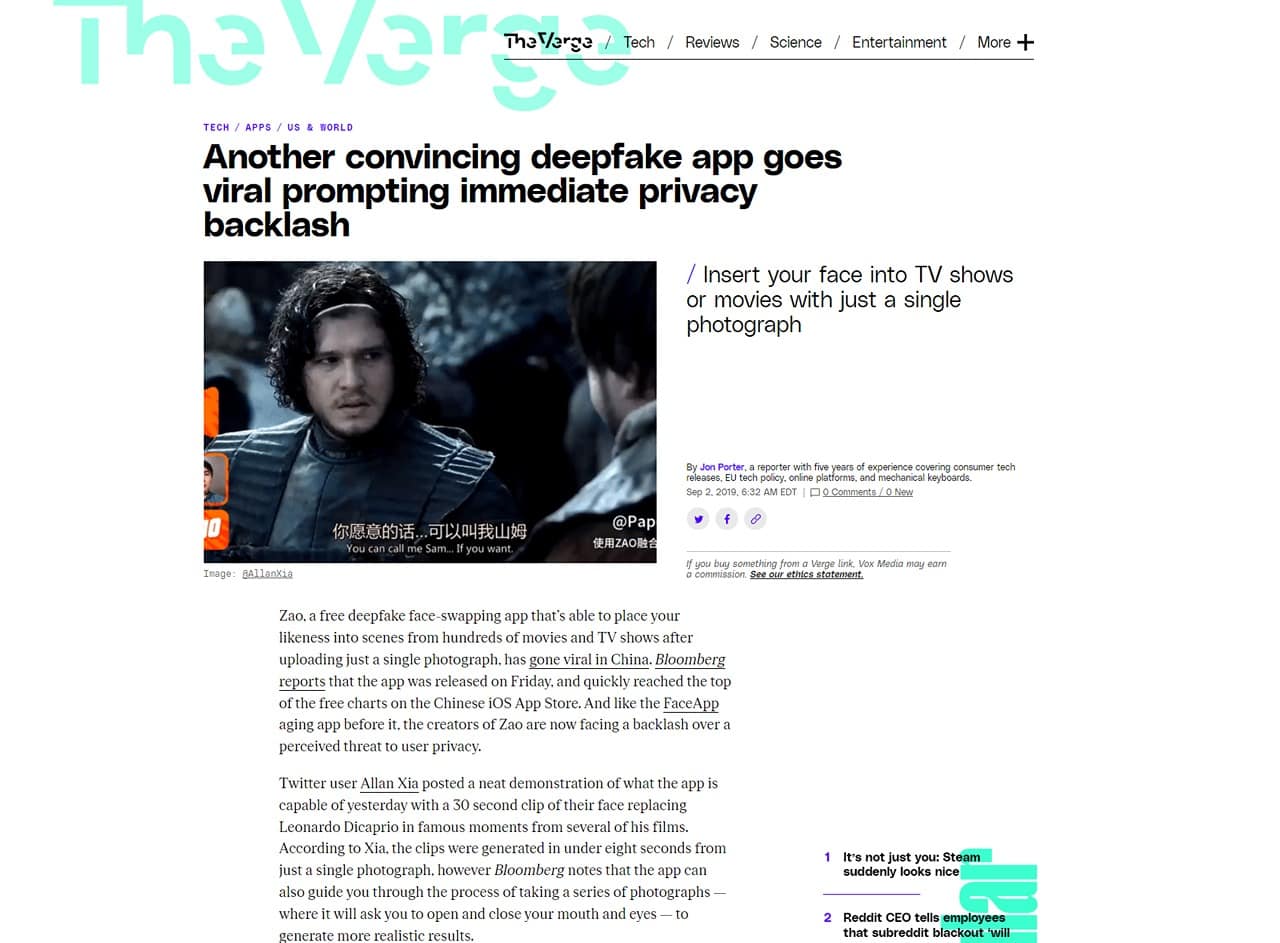
Zao is a popular deepfake app that uses AI technology to replace faces in scenes from movies, TV shows, and other video clips with the user’s own face.
Features & Description
Zao is a free face-swapping deepfake app that has taken the world by storm since its launch in 2019. It uses artificial intelligence and machine learning techniques to create realistic-looking videos with your face swapped onto someone else’s body.
One of the unique features of Zao is its library of video templates, filters, and effects that can enhance the final product significantly. The app also allows for easy sharing of videos on social media platforms like Facebook, Twitter, Instagram, WeChat, and more.
Zao’s terms of service and privacy policy have come under scrutiny in the past due to unclear data collection practices but were later updated to clarify their policies.
Pros & Cons
Zao offers impressive deepfake capabilities, but it has faced criticism for privacy concerns and unclear terms. The following table presents the pros and cons of the Zao app to help you make an informed decision:
| Pros | Cons |
|---|---|
| Highly advanced deepfake technology | Significant privacy concerns |
| Minimal data input required | Extensive user data collected and stored in China |
| Available for both iOS and Android platforms | Unclear terms and conditions regarding copyright |
| Creates convincing deepfakes with famous actors | Has faced legal challenges in China |
| Free to download and use | Could be used for fraudulent activities |
MyHeritage Deep Nostalgia
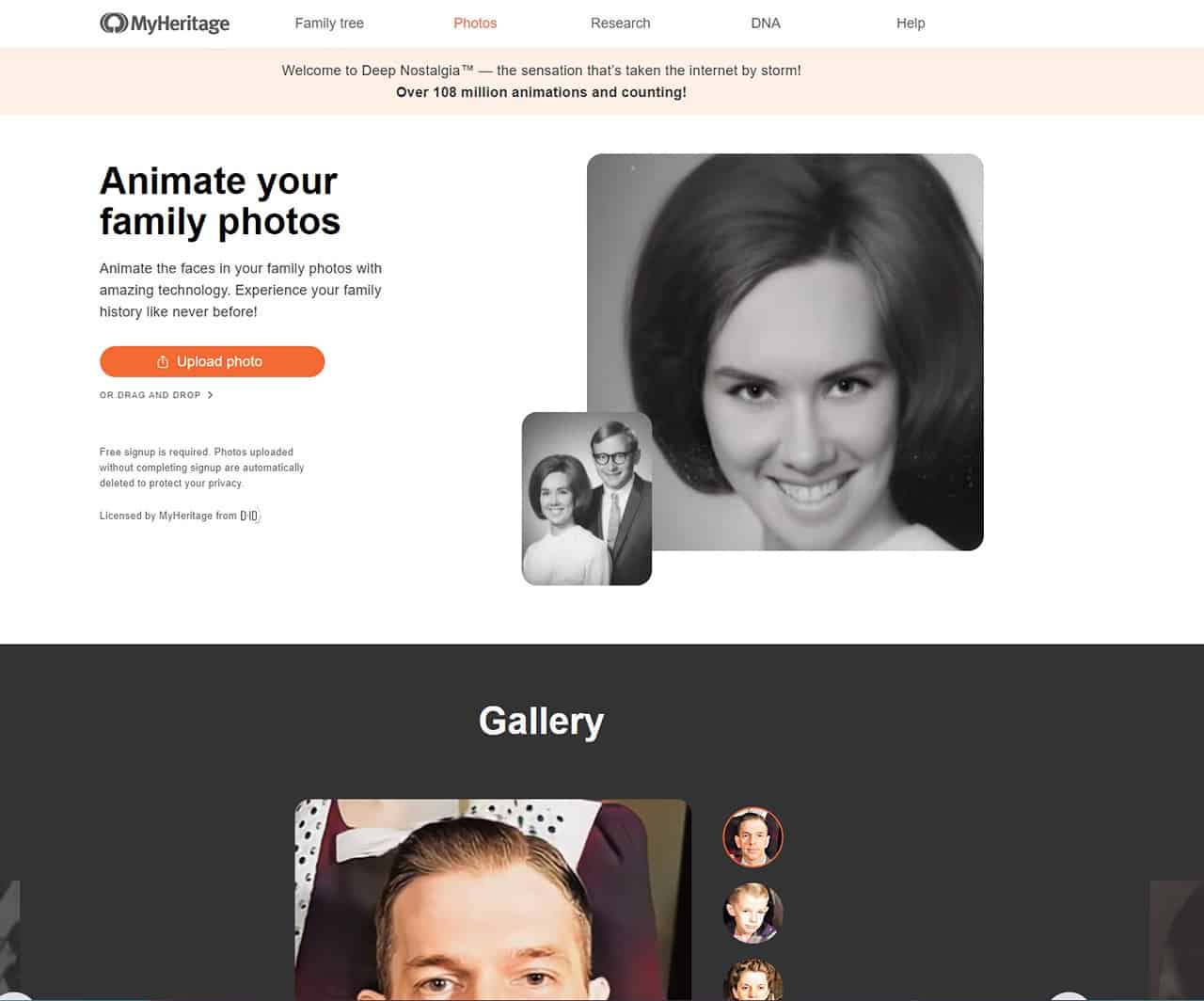
MyHeritage’s Deep Nostalgia feature can animate old photos, creating an effect similar to the moving pictures in Harry Potter. See how this deepfake generator works and explore its features, pros, and cons.
Features & Description
MyHeritage’s Deep Nostalgia is an AI-powered feature that brings old photos to life by animating them. Using deepfake technology, the feature creates a short video clip of a person in the photo blinking their eyes, turning their head and even smiling.
Deep Nostalgia has received both positive and negative feedback for its ability to bring old memories back to life. Some users have expressed discomfort with the idea of manipulating old photos in this way.
However, it remains one of the most popular features within MyHeritage’s suite of tools for genealogy research.
Pros & Cons
MyHeritage Deep Nostalgia has its share of advantages and disadvantages, which users need to weigh before deciding to use the application. Here’s a breakdown of some of the most notable pros and cons:
| Pros | Cons |
|---|---|
| Brings old photos to life, providing a unique, emotional experience for users | Raises ethical concerns about the potential misuse of the technology |
| Simple and user-friendly, making it accessible to everyone | Detection tools to identify deepfakes can be unreliable, making it more difficult for users to discern between real and manipulated content |
| Ample selection of pre-generated animations to choose from | May not provide the level of customization desired by some users |
| Integrates with MyHeritage’s family tree and genealogy services for an enriched personal history experience | Users must sign up for a paid subscription to access the full range of features |
Wombo
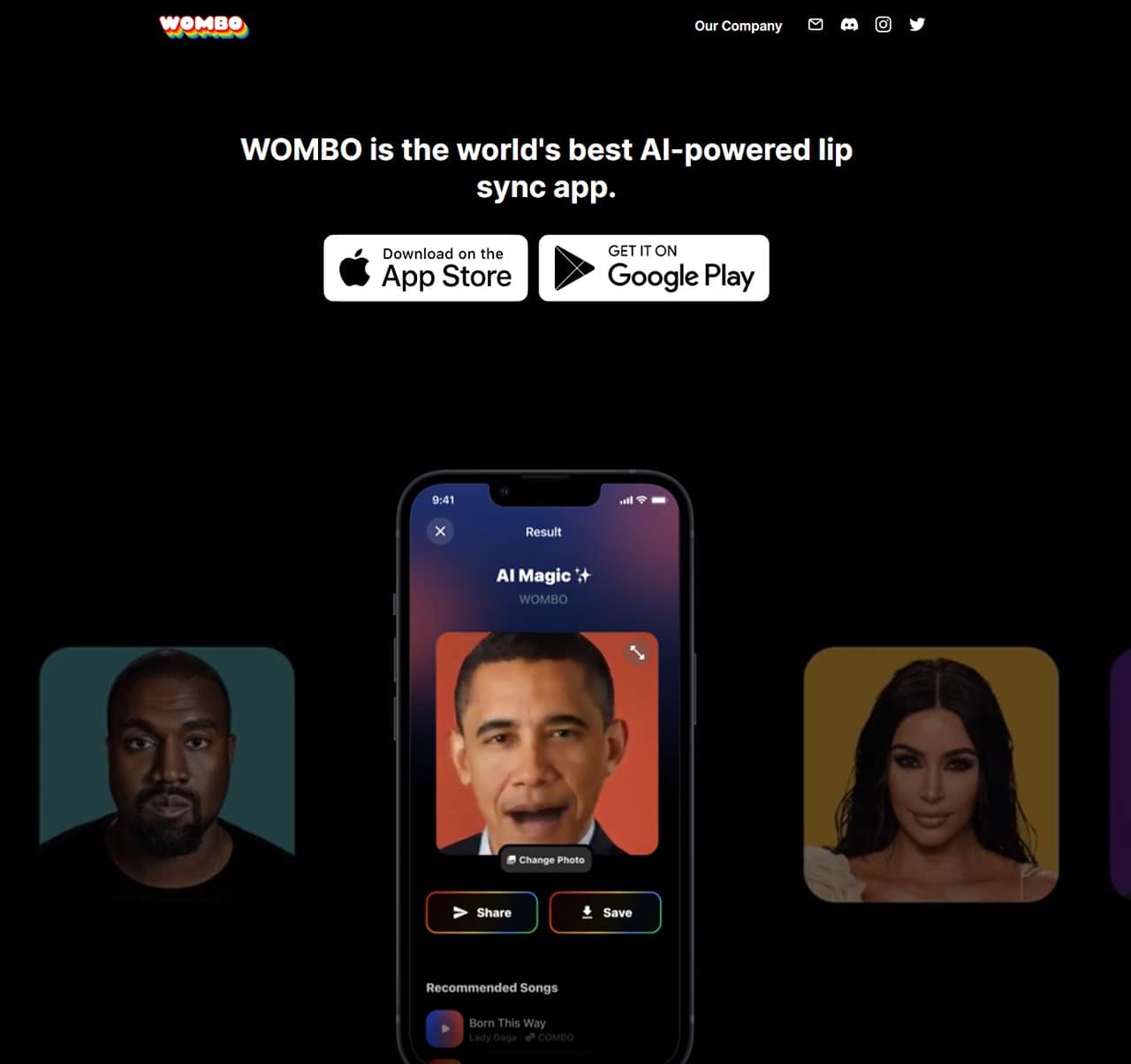
Wombo is a mobile app that can turn any still image into a lip-syncing video by using AI technology.
Features & Description
Wombo is a fun and popular lip-syncing app that uses deepfake technology to create singing faces from images. With Wombo, users can upload a photo of themselves or someone else, select one of the 15 songs available in the app, and watch as their chosen image is transformed into a face that appears to sing along with the lyrics.
While Wombo is not specifically designed for creating deepfakes, it demonstrates how advanced artificial intelligence has become in recent years when it comes to manipulating digital media.
However, like all other deepfake apps and websites, Wombo raises ethical concerns regarding its potential misuse for misleading people or misrepresenting individuals without their consent.
Pros & Cons
Wombo is a popular deepfake generator that has gained a lot of attention for its ease of use and entertaining results. However, it’s important to weigh the pros and cons of using Wombo before diving in.
| Pros | Cons |
|---|---|
| Quick and easy to use, making it accessible for all users. | Privacy concerns due to the requirement of uploading images. |
| Entertaining results that can be shared on social media platforms. | May lead to misuse of the technology without explicit consent of the person featured in the images. |
| Features 15 songs for lip-syncing purposes. | Limited song selection may not cater to all users’ preferences. |
| Free to use, allowing users to explore the world of deepfakes without any financial commitment. | Advertisements within the app may be annoying for some users. |
| Constant updates and improvements to enhance user experience. | Potential ethical concerns surrounding deepfake technology. |
DeepFaceLab
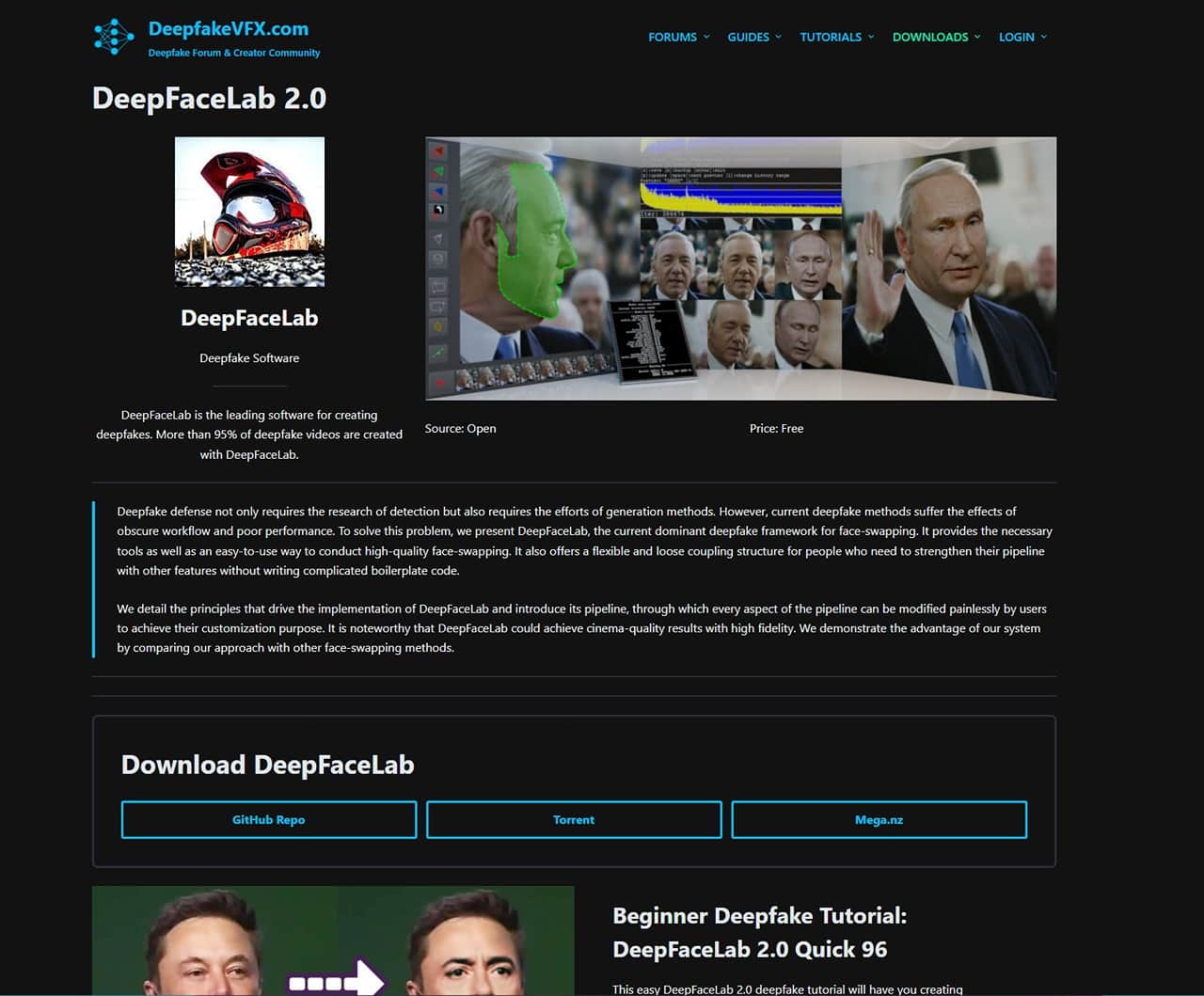
DeepFaceLab is a Windows program built primarily for researchers and students of computer vision, allowing for the creation of deepfake videos.
Features & Description
DeepFaceLab is a powerful, open-source Windows program designed for creating deepfake videos primarily for computer vision researchers and students. It uses machine learning algorithms to generate highly realistic face-swapping videos by combining and morphing real images of people’s faces.
One of DeepFaceLab’s key features is its use of generative adversarial networks (GANs) framework, which enables it to train models capable of generating deepfakes with high accuracy.
Additionally, the software supports GPU acceleration for faster rendering times and has built-in functions for facial animation and video editing.
Pros & Cons
DeepFaceLab is often hailed as a powerful deepfake generator, but like any technology, it comes with its own set of advantages and disadvantages. Below is a table outlining the pros and cons of DeepFaceLab to help you better understand its capabilities and limitations.
| Pros | Cons |
|---|---|
| Highly customizable and flexible, allowing users to create unique deepfakes. | It has a steeper learning curve, which may be challenging for beginners. |
| Primarily built for researchers and students of computer vision, it contributes to the advancement of deepfake technology. | The software is only available for Windows, limiting its accessibility to users of other operating systems. |
| Provides a multitude of tools for creating deepfake videos, including face swapping, masking, and more. | Requires a powerful computer with a dedicated GPU for optimal performance, which may not be feasible for some users. |
| Free and open-source, allowing users to modify and improve the software as needed. | Lengthy training times for the AI model can be time-consuming and resource-intensive. |
| Uses high-quality images and videos with minimal noise for best results, as recommended in the [IMPORTANT FACTS]. | Due to its power and flexibility, it bears the potential for misuse, as mentioned in the [IMPORTANT FACTS]. |
FaceApp
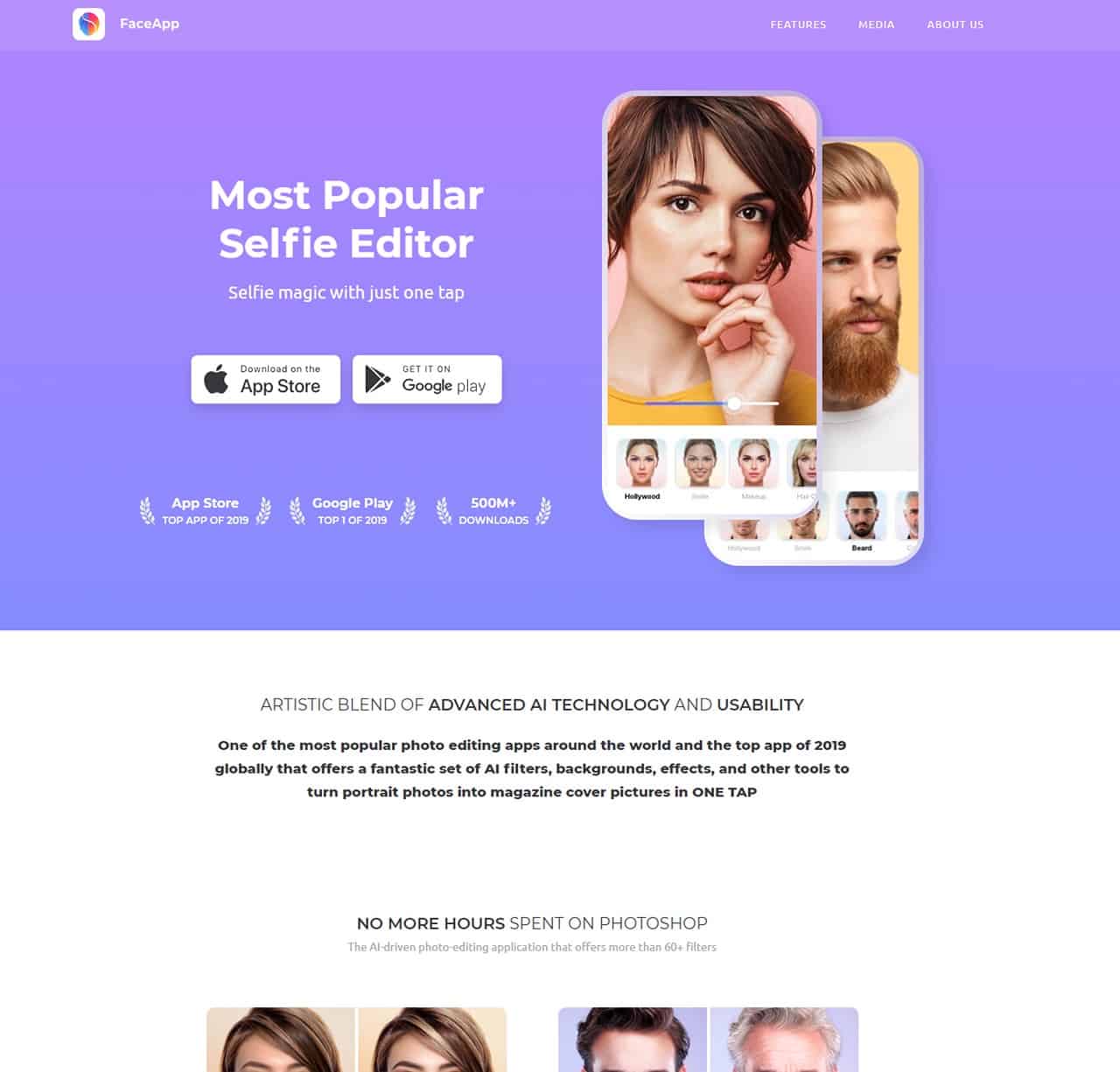
FaceApp is a mobile app that uses AI technology to transform selfies into different looks, including aging and gender-swapping.
Features & Description
FaceApp is an AI-powered photo editing app that allows users to transform their appearance in a variety of ways. The app uses deep learning technology to apply realistic filters and effects, such as adding wrinkles or altering hair color.
One of the most popular features of FaceApp is its ability to add smiles, change backgrounds, and swap faces with other people’s photos. Another great feature is its “beautifying” tools which enhance skin clarity and tone while removing blemishes like pimples or dark circles under the eyes.
While FaceApp initially gained popularity for fun purposes, concerns have since been raised about potential privacy risks associated with uploading personal photos to the app’s servers.
Pros & Cons
FaceApp has its own set of advantages and drawbacks that users should be aware of before deciding whether to use this deepfake generator. Here, we have outlined the pros and cons of FaceApp in a table format for easy reference.
| Pros | Cons |
|---|---|
| Easy-to-use interface with a wide range of filters and effects. | Data privacy concerns due to the company’s ties with Russia and unclear data storage practices. |
| High-quality deepfake results with minimal noise and low compression. | Requires a stable internet connection to work effectively. |
| Available for both Android and iOS devices. | Some features are only accessible through the paid Pro version. |
| Regular updates and improvements to keep up with technological advancements. | Potential ethical concerns related to the creation of deepfakes without the explicit permission of the individual being depicted. |
Synthesia IO
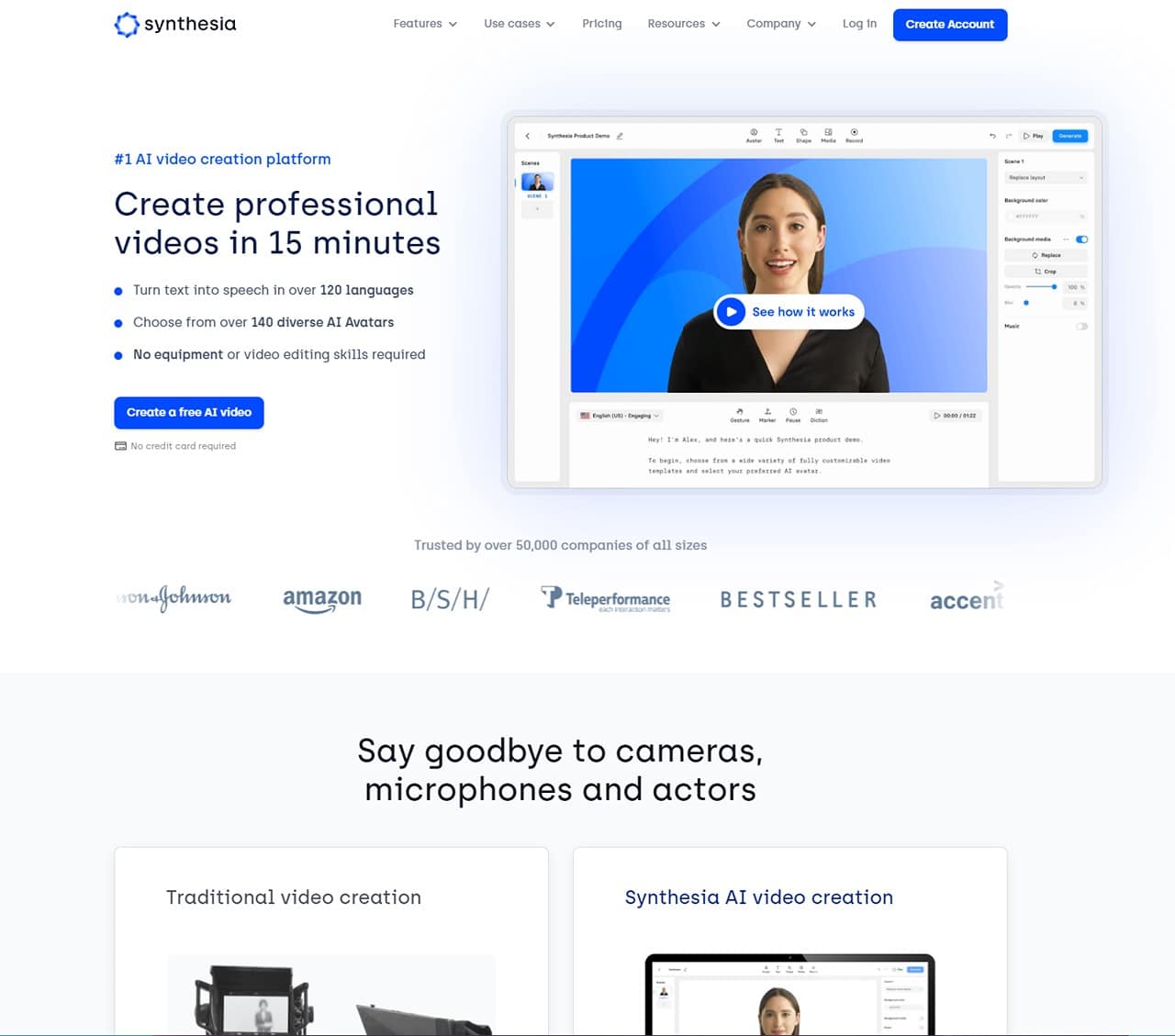
Synthesia IO is an AI-powered video generation platform that uses text-to-image capabilities to create realistic-looking videos with custom avatars.
Features & Description
Synthesia IO is a powerful AI video creation platform that allows users to generate high-quality videos from text in just minutes. One of the best things about Synthesia IO is its user-friendly interface, making it easy for even amateur users to create professional-looking content.
The software offers a range of features, including face swapping between humans and animations or toons in any video or image, text-to-image capabilities, refacing capabilities, lip-syncing, and more.
Synthesia IO is not only affordable but reliable as well – it uses deep learning techniques such as Generative Adversarial Networks (GANs) framework to create realistic and convincing deepfakes that are indistinguishable from real videos at first glance.
They offer pricing plans ranging from free trials and commercial licenses to annual subscriptions and one-time fees depending on your needs.
Pros & Cons
Synthesia IO has several pros and cons that users must be aware of before utilizing the deepfake generator.
| Pros | Cons |
|---|---|
| Affordability: Synthesia IO offers an affordable option for users who want to create deepfake content. | Risk of Misuse: The accessibility and affordability of the software can lead to it being used by individuals with malicious intent. |
| Easy-to-use interface: The software provides an intuitive interface, making it simple for users to navigate and generate deepfakes. | Privacy Concerns: Deepfake technology raises ethical concerns, especially when individuals’ images or videos are used without their explicit permission. |
| High-quality video generation: Synthesia IO is capable of producing high-quality deepfake videos quickly, ensuring impressive results. | Spreading False Information: Deepfakes created using the software have the potential to spread misinformation, which poses significant risks to individuals and society. |
| Wide range of features: Synthesia IO offers various capabilities for users to create unique and impressive deepfake content. | Legal and Ethical issues: Using deepfakes for illegal purposes or without permission can lead to legal consequences and ethical dilemmas. |
Jiggy
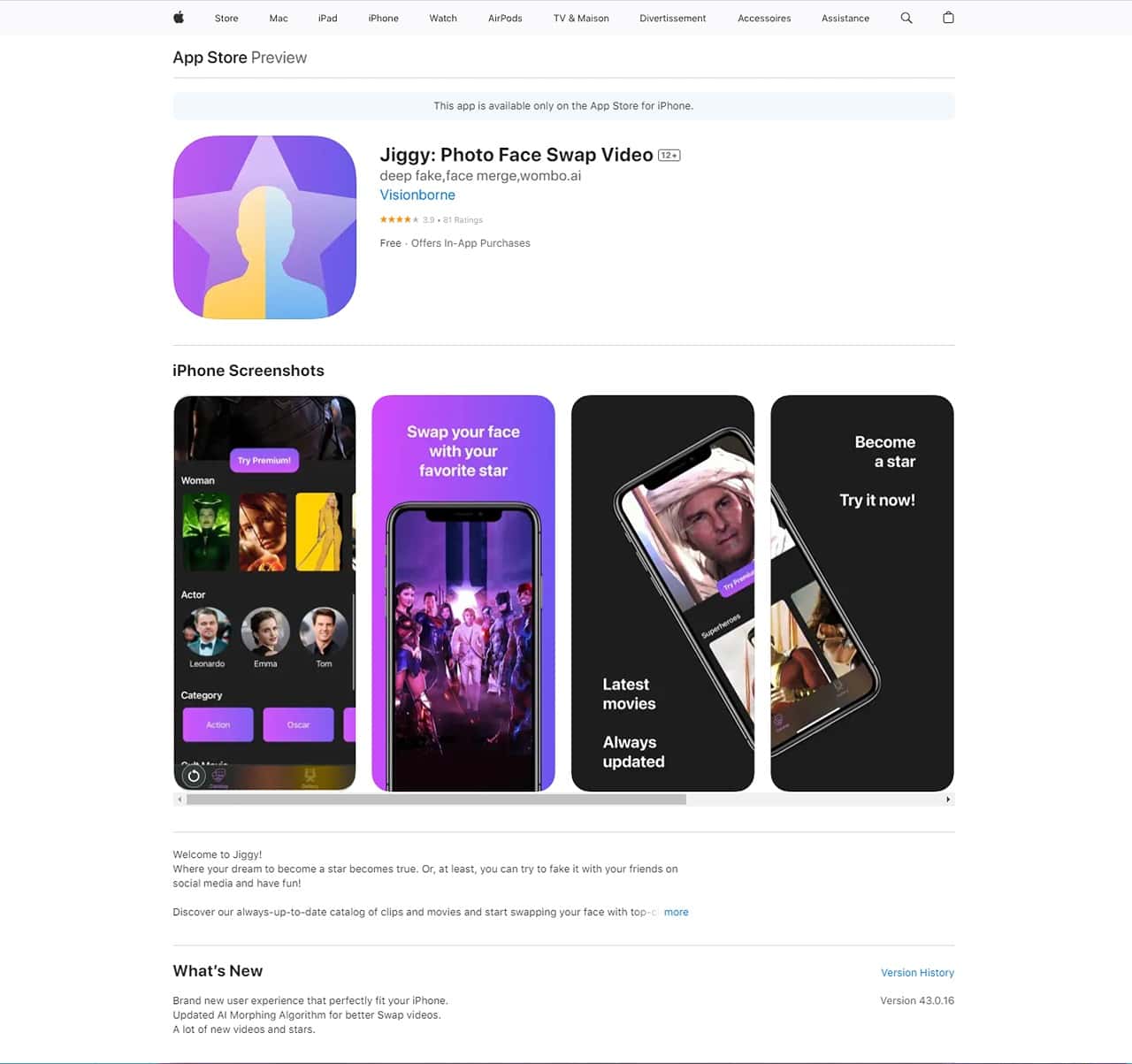
Features & Description (Jiggy): Jiggy is a mobile deepfake app that allows users to swap their faces with celebrities, politicians, athletes, and more in real time.
Features & Description
Jiggy is a unique deepfake app that allows users to bring their still photos to life. With Jiggy, you can create animated videos with realistic movement and facial expressions through the use of deep learning technology.
The app offers a variety of animation styles such as dancing, singing, and talking which makes it perfect for social media posts like Instagram or TikTok.
What’s great about Jiggy is its user-friendly interface which allows for easy customization of animations by changing the background music or adjusting the speed of the animation.
Both Android and iOS devices can use Jiggy freely though it has limited features in trial mode but is available at no cost with a watermark on your final product.
However, its premium version offers additional customization options without watermarking your content after rendering. The positive reviews given to this application are mainly due to its impressive results and ease-of-use among other top-rated deepfake generators discussed in this article, making them viable alternatives for creating impressive custom avatars quickly and easily online while enjoying various benefits that come with these services like monthly subscriptions plans instead one-time fees-based system used traditionally.
Pros & Cons
Jiggy is a popular deepfake generator that stands out for its unique feature of letting users create deepfakes with realistic dance moves. This innovative app has its fair share of advantages and drawbacks, especially when considering the ethical implications surrounding deepfakes. Let’s examine the pros and cons of Jiggy in the table below.
| Pros | Cons |
|---|---|
| Easy to use interface makes it accessible for users of all skill levels. | Potential ethical concerns when using other people’s images without their consent. |
| Creates deepfakes with realistic dance moves, providing a novel and entertaining appeal. | The possibility of misuse in spreading misinformation or causing harm. |
| Wide range of available dance moves to choose from, offering creative freedom to users. | Deepfake technology is not foolproof, which can lead to less realistic results in some cases. |
| Legal to use as long as it’s explicitly mentioned that the content is deepfake and not intended to mislead. | Reliability of available deepfake detection tools varies, making it challenging to prevent misuse. |
| Ethical use requires users to obtain explicit permission from individuals whose videos or images are being used. | Users must be aware of potential consequences when creating and sharing deepfakes, even for entertainment purposes. |
Avatarify
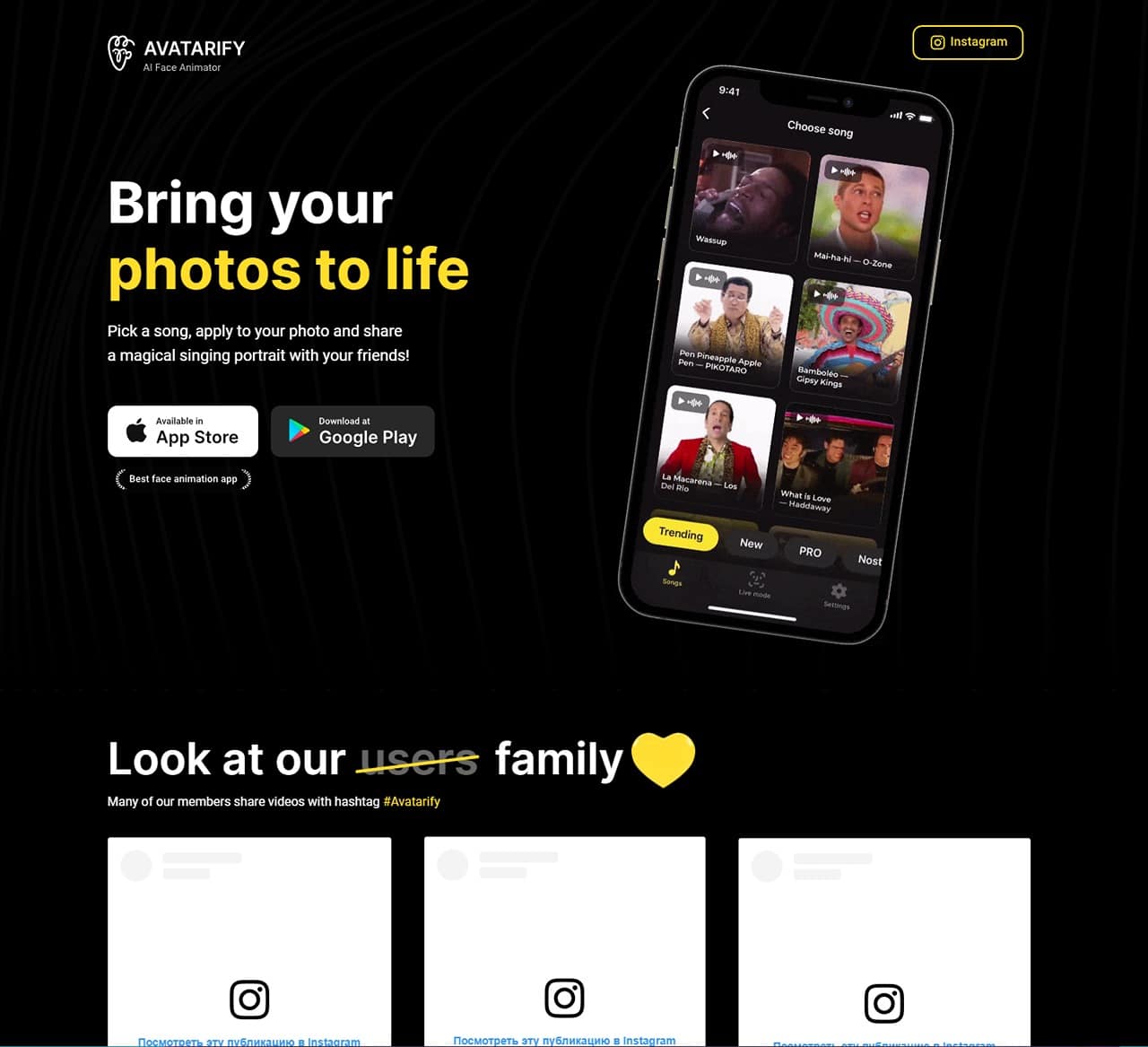
Avatarify is an AI-based deepfake app that allows users to animate themselves and other people, creating funny videos that are popular on social media.
Features & Description
One of the top 9 deepfake generators for geeks is Avatarify, an AI-powered tool that allows users to animate static facial images with a variety of expressions and movements.
With machine learning algorithms analyzing facial features, Avatarify can create realistic and high-quality animations while allowing users to adjust the intensity of the animation for more subtle or exaggerated effects.
The app offers a wide range of avatars to choose from, including famous personalities, animals, and fictional characters. One advantage of Avatarify is that it does not require a large amount of data to create convincing deepfakes.
The tool is available as a free software download for Windows and MacOS, with additional features available for purchase.
Pros & Cons
Avatarify is an AI-powered, open-source deepfake generator that allows users to animate images and create unique results. It has become popular for its ease of use and diverse applications. To understand Avatarify’s strengths and weaknesses, let’s explore its pros and cons.
| Pros | Cons |
|---|---|
| Easy to use | Potential for misuse |
| Open-source and free to use | Requires a powerful GPU |
| Real-time animation capabilities | Limited customization options |
| Compatible with popular platforms like Skype and Zoom | Not as realistic as some other deepfake generators |
| Active development and community support | Privacy concerns due to facial recognition technologies |
How To Detect And Prevent Deepfake Misuse
Detecting and preventing deepfake misuse is becoming increasingly crucial as technology continues to improve. One way to detect a deepfake is by paying attention to small details, such as incorrect lighting or mismatched eye movements.
Another method is through the use of forensic tools that can analyze an image or video for alterations.
Preventing deepfake misuse requires a collective effort from both individuals and institutions. Educating oneself on how to identify deepfakes can help prevent falling victim to them, while platforms like Facebook and Twitter are implementing measures such as fact-checking labels on content deemed false or misleading.
The potential risks associated with deepfakes have led some companies to develop anti-deep fake technologies, such as DeepTrace and Truepic, which provide digital fingerprints for authentic images and videos.
Frequently Asked Questions About Deepfake Generators
What is a deepfake generator, and how does it work?
A deepfake generator is an AI-powered software that uses machine learning algorithms to superimpose facial expressions, movements, and voices onto someone else’s face in order to create realistic videos or images of the other person doing something they never actually did. The software analyzes source material (i.e., past footage of a celebrity), then creates new output based on this data using various techniques such as neural networking.
What are the potential benefits of using a deepfake generator?
Deepfakes have become increasingly popular for entertainment purposes, including creating humorous parodies that poke fun at celebrities or public figures. They can also be used for artistic purposes, such as creating music videos or films with lifelike renditions of different characters.
What are some ethical considerations when using deepfake generators?
There are numerous ethical concerns surrounding the use of deepfakes, especially in political situations where fake video evidence could be manipulated to sway voters or incite violence against individuals or groups based on fabricated events. Additionally, these tools could easily lead to cyberbullying and harassment by allowing users to create harmful content about others without their consent.
Are there any legal regulations around the creation and distribution of deepfakes?
Legal regulations regarding the creation and distribution of deepfakes vary depending on the jurisdiction, but many countries are working towards implementing stricter laws around their use due to increasing public concerns over privacy violations and potential socio-political implications stemming from their misuse.
Conclusion
In conclusion, the world of deepfake technology is rapidly evolving, and with new apps and software emerging every day, it’s essential to stay informed on the latest developments.
Our exploration of the top 9 best deepfake generators has highlighted their features, pros, cons, pricing plans, and ethical concerns. It’s crucial to use these powerful tools ethically and responsibly while always obtaining explicit permission from individuals whose images or videos may be used.
Remember that deepfakes have both potential risks and benefits when used for personal or commercial purposes.
